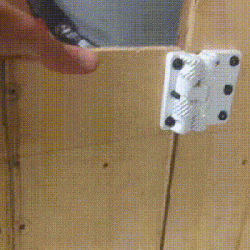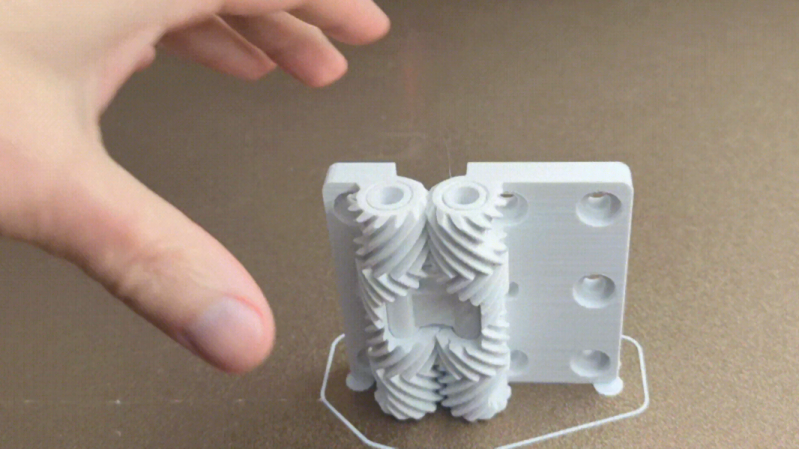3D printers have come a long way from cranking out things like bottle openers and coat pegs, and [E. Soderberg]’s Print in Place Geared Hinge is a pretty nifty demonstration of that. This hinge is designed as a print-in-place part, meaning it is 3D printed as a single piece, requiring no assembly. Not only that, but the herringbone gears constrain the sturdy device in a way that helps it support heavy loads.
 Of course, hinges — even strong ones — are not particularly hard to find items. They’re available in a mind-boggling array of shapes and sizes. But what’s interesting about this design is that it shows what’s easily within the reach of just about any hobbyist nowadays. Not that long ago, designing and creating an object like this would not have been accessible to most home enthusiasts. Making it without a modern 3D printer would certainly have been a challenge in its own right.
Of course, hinges — even strong ones — are not particularly hard to find items. They’re available in a mind-boggling array of shapes and sizes. But what’s interesting about this design is that it shows what’s easily within the reach of just about any hobbyist nowadays. Not that long ago, designing and creating an object like this would not have been accessible to most home enthusiasts. Making it without a modern 3D printer would certainly have been a challenge in its own right.
It doesn’t always matter that a comparable (or superior) off-the-shelf part is available; an adequate part that can be created in one’s own workshop has a value all its own. Plus, it’s fun to design and make things, sometimes for their own sake. After all, things like 3D-printed custom switch assemblies would not exist if everyone were satisfied with the ability to just order some Cherry MX switches and call it a day.
















Nice project.
This is really cool!
Gears have always been fascinating to me as there are so many ways to get the geometry just wrong enough that they will look perfectly fine but won’t work.
I still think that they are a bit of a black art.
Really cool. I’d personally use mono-directional helical gears rather than chevron-based and use something else for vertical location, chevron-based might eventually bind up as they wear or if someone accidentally puts a little to much force on them and causes them to skip a line.
Maybe I’m making an issue out of nothing, though, that demo with them supporting 210lb of dumbbells is pretty convincing.
If the gears twist the same direction, you’re putting sideways torque on the middle link (whatever it’s called); imagine the door’s trying to slide them apart. Herringbone gears are self-centering so all it takes to keep them together is tension.
Is this post about the hinge or about how great 3D printing is? The latter would be kind of old news?
> the herringbone gears constrain the sturdy device in a way that helps it support heavy loads.
How?
I doubt it’s stronger than the equivalent ordinary design with same volume (like the linkage inside of it).
The feature of this type of geared hinge seems to be that it has a virtual fulcrum (are those the right words?).
That would have been interesting to read about…
“helps it support heavy loads”
“How?”
If they had used regular straight teethed gears, the gear would hold no weight what so ever, then the weight of the door have to rest on part of the mechanism, probably the coupling in the center. This would create a point that would suffer a lot of wear and eventually lead to failure.
The heron bone gears mean that the weight of the door is being held by the length of gear (rather than just one or two resting/supporting points).
Another example of this is in axle-less propellers. With no center axle, the propeller must be driven and supported on the outside. If straight gears where used, then the propeller would be able to slide out of the gears then is start generating force (or require some sort of thrust bearing to stop it doing so). If you use heron bone gears, the Vs “lock” the gear into place preventing it from sliding out.
Consider this print in place gear bearing:
https://www.thingiverse.com/thing:53451
Once printed, it’s not possible (well easy) to press the center gear out. If this was flat toothed gears, it would be very easy to press the center gear out.
Neat!
“herring” not “heron”-bone
You have no say here in that you haven’t even posted a credible ID for yourself.
> Not that long ago, designing and creating an object like this would not have been accessible to most home enthusiasts.
I would have no idea how to design this. The best I can do is some minor stuff with TinkerCAD. How *does* one design something like this?
If I were going to model up this design I would start with a known working gear as a reference, scale it to a suitable size, extrude it to the length required, then model my hinge around the modified gear shape.
If you are new to modeling in general, there are countless tutorials on youtube for everything from fusion360 to autocad to free cad et. al.
The way I taught myself to be comfortable with modeling was to buy a nice pair of calipers and use them to measure a random object out of my junk drawer and tasked myself with recreating that object in fusion360. In the beginning there was a lot of googleing for how to do this or how to do that, but the exercise led me to feeling quite proficient when it comes to modeling functional items needed for the things I work with.
Good luck, I hope this helps ;)
One way is extruding a regular (involute) gear profile with a twist. There are alternatives: https://forums.autodesk.com/t5/fusion-360-design-validate/twist-while-extruding/td-p/6872419
There is also OpenSCAD. If you’ve done anything programming or scripting it can be easy to pick up (even if you’ve not done any programming OpenSCAD could be a good place to start). There are a bunch of gears libraries you can (download/)import and use in your own design (including herring bone).
You can also script with python directly in FreeCAD
I like the design and think it looks very interesting. However, this would be a nasty pinch point for fingers….
I’ve 3d printed a few variations of herring bone planetary gears things like this:
https://www.thingiverse.com/thing:53451
In my house they became known as “the ouchie devices” due to the number of blood blisters it gave people (well, mainly me).
Although, I think it would be possible to design one with a covering that preventing the gears from being exposed. There are also pre-existing off-the-self door-jam/dangerous-hinge finger protection options as well. (Things I didn’t think about before parenthood.)
I’ve heard (I think that I’ve read it in a hackaday comment :) that plastics have a tendency to “flow” when stressed for extended periods of time. My limited experience with 3d-printed plastics seems to confirm this. The hinge may support these loads for the duration of the test, but I wonder how it would look after a week under such stress.
All the more reason to do a lost-PLA casting into brass, bronze, or aluminum. :P
Listening to Joel B! Preach the truth brother!
I doubt that would work with this one-piece print :)
You could also find a way to design it as a multi part piece.
We have plastic rolling carts here at work that are 500lb rated capacity. We put a piece of equipment on one that was about 75lb or so to give it some height. Fast forward about 18 months and I come in one morning to find the top shelf completely collapsed and broken apart under the weight.
It’s called creep, and it’s not flowing, it’s permanent deformation under stress.
I like the design and all, but I can’t quite think of an application for it. The only think I can think of is an oddly shaped door in an otherwise flat surface that opens inwards into something?
95kg that would be sufficient to hold up one of my boys swinging on the door (at least until I print a spare )
If they pinched dithering fingers in it they may think twice about swinging on the door again …. maybe not
You have a 3d printer that can print a spare boy?
Sorry, couldn’t resist ..
It’s a 9-month print cycle 🤔
Being a cabinet maker,i could see these replacing Euro hinges that we use now. These have fewer parts.
Are they going to have much fewer parts after they engineer in the rest of the components needed to make them adjustable? It’s kind of nice to be able to adjust the hinges so the doors line up properly.
I would say that based on design, these are not adjustable. But there’s nothing keeping someone from carrying this design onto something that is adjustable!
It also misses the ability to customize the part to your particular need. A week ago I was searching for a hinge for project which has specific size requirements. Finding an exact fit with a commercial product is a matter of luck and the amount of time you are willing to spend searching. Your own design can be both better and quicker. I am going to use this design for my project.